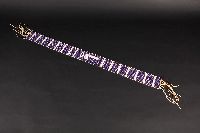Home > Europeans Arrive > The New Neighbours - Europeans Arrive
The New Neighbours
Before 1607, several groups from France had attempted to settle in Canada. The winter, illness (in particular scurvy) and the inhospitable environment quickly discouraged the new arrivals. After enduring a single winter, the survivors wanted only one thing: to return to Europe. It was not until the founding of Quebec, in 1608, that the French established a permanent settlement in eastern Canada.
Called New France, the French colony soon joined the First Nations trading network. In fact, the French settlements were most often located near places where trade gatherings took place such as Tadoussac, Quebec, Trois-Rivières and Montreal.
Not all the First Nations had direct access to European goods. The nations whose territories were west of the Great Lakes would have had to travel immense distances in order to reach the places where trading was done with Europeans. These groups that lived farther away still managed to obtain European goods. Other nations acted as intermediaries travelling to the trade gatherings and bringing back European goods.
At first, the French attempted to adapt their way of doing business to that of the First Nations. Speeches and the exchange of gifts, along with requests for help in war expeditions, remained part of the trade process. However, little by little, the French abandoned this way of trading.
But they were not the only Europeans in North America. The Dutch, the Swedish and the British shared the east coast of the territory that would become the United States. These nations also built trading posts to do business with the First Nations.
In 1609, the Dutch established themselves on the island of Manhattan, in what is now the State of New York. One of the best known Dutch trading posts was at Albany. Established further inland, they traded with the nations of the Iroquois Confederacy. The Swedish settled not far from the Dutch in 1633.
The English, for their part, had established themselves along the Atlantic coast. In the course of the conflicts among the European powers, the British took over the trading posts of the other nations, including the one at Albany. The First Nations who had previously traded with the Dutch allied themselves with the British in order to maintain access to European goods.
The First Nations who made alliances with the English and the French soon realized that these new neighbours did not get along. Since forming a trade alliance also meant forming a military alliance, the First Nations found themselves involved in conflicts between Europeans.









